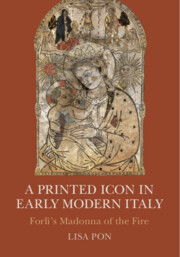One - Iconography: Madonna and Child
from Part I - Thing
Published online by Cambridge University Press: 05 April 2015
Summary
On the scorching cloud of vivid flame,
As a queen on a throne of glory,
By a beaming sign of new victory,
You reign, Mary, over this city.
Traditional hymn to Forlì's Madonna of the FireSometime in early 1636, Giuliano Bezzi was struck by a terrible fever. Born in the Northern Italian city of Forlì in 1592, Bezzi was a learned man and gifted writer who was serving as secretary to the city's magistrates when his life was threatened by this grave illness. He and his wife, Chiara Fachinei, surely addressed prayers for his return to good health to the local manifestation of the Virgin Mary, Forlì's Madonna of the Fire (Plate I). For in Bezzi's lifetime, as in ours, the people of Forlì called upon the Madonna of the Fire as their special spiritual advocate not only for communal catastrophes such as war and famine, but also in times of personal distress including illness, injury, or accident. In the case of Bezzi's potentially fatal illness, their prayers were answered: as Bezzi himself wrote soon thereafter, the Madonna of the Fire “pull[ed] me from my sickbed to the disbelief of the doctors, … [and] made me overcome a mortal fever.”
Giuliano Bezzi published those words in 1637, in one of the many Forlivese texts in praise of the Madonna of the Fire. For more than half a millennium now, natives of Forlì have written to celebrate the Madonna of the Fire, from the prosaic fifteenth-century chronicle entry of Giovanni di Mastro Pedrino to the soaring verses of the tradition hymn (in the Epigraph) that liken the Madonna's “vivid flame” to a regal “throne of glory.” Yet despite the opening personal reference to his recovery from fever, Bezzi's text is perhaps the most important piece of public writing about the Madonna of the Fire.
- Type
- Chapter
- Information
- A Printed Icon in Early Modern ItalyForlì's Madonna of the Fire, pp. 13 - 38Publisher: Cambridge University PressPrint publication year: 2015



